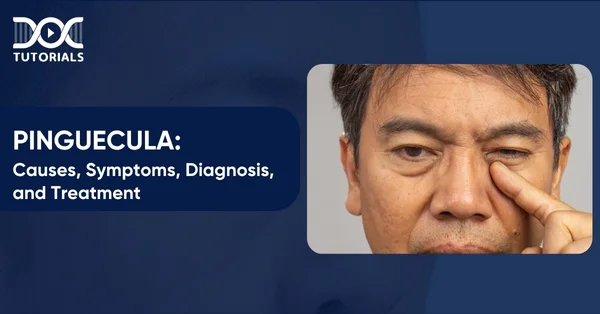Pinguecula: Causes, Symptoms, Diagnosis, and Treatment

A pinguecula is a harmless, yellow-white growth on the surface of the eye. It is primarily found on the nasal aspect of the eye, near the nose, but may also be present on the opposite side. Although this yellowish, lump-like bump on the conjunctiva may not appear very serious, its causes, characteristics, and treatment methods play a pivotal role in the proper diagnosis and treatment of the patient. It is typically non-pathogenic but may cause discomfort, making it an object of practical interest to clinicians.
The guide will break down the topic in a very clear and concise manner. It is ideal for students targeting the NEET PG, FMGE, and other medical entrance tests. Keep reading for detailed insight!
What is a Pinguecula?
“Pinguecula” is a Latin word meaning “fatty,” owing to the fact that the lump contains a protein-fat and calcium content. These protrusions are benign and have no general symptoms. They are normally seen by people as a small patch of yellow on the white of the eye.
At the microscopic level, pinguecula is defined by the presence of irregular elastin and collagen fibres in the conjunctival tissue. The tissue underneath the conjunctival surface shows elastotic degeneration (degraded elastic fibres) and collagen nodule formation. A pinguecula is usually devoid of the vasculature growth seen in a close cousin lesion known as a pterygium. Knowledge of this pathology explains why pinguecula is a benign condition.
Pinguecula needs to be recognised by both clinical physicians and patients. When you see a tiny yellowish bump on the conjunctiva (no discharge, no pain), presume a pinguecula instead of an infection or tumour. Patients are often reassured when doctors explain that this bump is usually nothing to worry about (merely the body reacting to sun damage).
What are the Causes and Risk Factors of Pinguecula?
Pinguecula is formed by a chronic stimulation of conjunctival tissue leading to its degeneration. Major causes and risk factors include:
- Ultraviolet (UV) Light Exposure: UV rays and sun exposure over a long time result in degeneration of the conjunctiva.
- Environmental Irritants: Sand, dust, dry air, and even wind irritate the eye and can create the occurrence of pinguecula.
- Age: These developments increase with age, particularly in middle-aged and elderly adults.
- Geography: The risk is greater among individuals living close to the equator or in sunny climates with high UV light.
- Contact Lens Wear: Mechanical damage to the conjunctiva may occur through the frequent use of contact lenses. Some studies suggest contact lens wearers may develop pingueculae earlier, though findings vary.
What are the Symptoms of Pinguecula?
Most of the time, a pinguecula causes minimal or no symptoms. In this regard, here are some key factors to look out for:
- Visible Bump: Pinguecula appears as a raised, yellowish, or whitish spot on the white area of the eye.
- Dryness or Irritation: This may disrupt the tear film, resulting in a gritty sensation, dry eyes, or itchiness.
- Inflammation (pingueculitis): When the pinguecula is inflamed, there may be redness, tearfulness, and burning.
- Vision: Pinguecula produces almost no loss of vision. It is less invasive to the cornea compared to its cousin, the pterygium.
What is the Diagnosis Method for Pinguecula?
A pinguecula can be detected during a regular eye examination conducted by an ophthalmologist. They can magnify the conjunctiva using a slit lamp. In this examination, the colour and form of the pinguecula evidently contrast with those of other eye growths (such as a pterygium or conjunctival tumour).
If a pinguecula grows in an aggressive manner, it may develop into a pterygium. Pterygia are fleshy, wedge-shaped growths filled with blood vessels that may spread to the cornea.
What are the Treatment Options for Pinguecula?
In most cases, pinguecula treatment focuses on relieving discomfort. It may include:
- Observation: In case the pinguecula does not cause any discomfort to the patient, no medication is provided. Eye examinations should be conducted regularly to track any developments.
- Lubrication: The most common remedy is the use of artificial tears (preservative-free) to keep the eye wet and reduce dryness. This is particularly beneficial when the patient has a feeling of that continual scratchiness.
- Anti-inflammatory Medications: Redness and swelling of the inflamed pinguecula (pingueculitis) can be minimised with a brief course of topical steroid and antibiotic pinguecula eye drops.
- UV Protection: Further sun damage can be avoided by utilising sunglasses that shield the UVB and UVA spectrum. Eye protection (e.g. goggles) should also be used by the patients in windy or dusty conditions.
- Surgery: Pinguecula can be removed (excised) only when it produces serious symptoms or when it is cosmetically undesirable. The signs are excessive irritation that cannot be treated with drops, poor tolerance of contact lenses, or extension to the cornea.
Surgery entails the cutting off of the growth (usually with a conjunctival graft). Pinguecula may also recur even after removal, especially when there is continued exposure to UV. Nonetheless, conservative management and postoperative prospects are commonly quite favourable in patients.
To diminish the chances of recurrence, surgeons occasionally apply anti-scarring methods (such as mitomycin drops).
FAQs About Pinguecula
- Is a pinguecula dangerous or cancerous?
No. A pinguecula is a noncancerous growth. It triggers minimal irritation of the eyes, but it hardly causes other complications.
- Can a pinguecula resolve on its own?
No. A pinguecula that has already developed remains until it is surgically extracted.
- Does a pinguecula affect vision?
Rarely. Pinguecula often does not blur vision because it does not cover the cornea.
- What is the difference between pinguecula and pterygium?
They are both connected with sun damage. A pinguecula refers to a yellow, flat, or slightly elevated spot. A pterygium is more aggressive—it is fleshy, wedge-shaped, and has blood vessels. Pterygium is only capable of growing onto the cornea and interfering with vision.
- What triggers a pinguecula to grow or worsen?
It can be exacerbated by prolonged exposure to the sun and environmental factors. Other causes include chronic dry eye, irritation from contact lenses, and allergies.
Conclusion
In the world of ophthalmology, conditions like pinguecula may appear minor but hold significant clinical value, especially in medical exam preparation. From UV exposure to eye irritation, understanding these subtle signs and their management reflects a sharp diagnostic mind, something every medical student should aim for.
While it may appear alarming at first, this benign growth on the conjunctiva is often manageable with proper awareness, early diagnosis, and targeted treatment. Whether caused by UV exposure, environmental irritants, or ageing, recognising the symptoms and knowing when to consult an eye specialist can help prevent complications.
For aspiring medical professionals interested in ophthalmology or preparing for competitive exams like NEET PG, resources like DocTutorial NEET PG notes offer invaluable insights.
Check out our courses today!
Latest Blogs
-

INI CET Exam 2025: Your Roadmap to Success – Key Topics, Strategies, and Lessons from Last Year’s Papers
The INI CET exam is more than just a test; it’s a significant milestone for many medical students aiming to…
-

INI CET Exam Success: Previous Year Question Papers & Ultimate Guide – INI CET PYQ
One can feel overwhelmed while preparing for the INI CET (Institute of National Importance Combined Entrance Test). A vast syllabus,…
-

INI CET Exam Pattern 2024: A Complete Guide with Subject-Wise Weightage
The Institute of National Importance Combined Entrance Test (INI CET) is your key to entering some of the most prestigious…




